Early Childhood Education: Principles of Learning and Teaching Essay
VerifiedAdded on 2022/08/28
|12
|3784
|24
Essay
AI Summary
This essay delves into the multifaceted realm of early childhood education, examining various concepts and principles that shape a child's learning journey. It begins by highlighting the importance of high-quality early childhood education and the integration of early literacy and science. The essay then explores the influence of biblical principles, constructivism (cognitive and social), humanism, and postmodernism on teaching and learning methodologies. It discusses how these approaches impact the role of educators, the creation of learning environments, and the development of children's cognitive, social, and emotional skills. The essay also touches upon the developmental characteristics of early childhood, emphasizing the physical, cognitive, and social growth during this crucial period. Ultimately, the essay provides a comprehensive overview of diverse perspectives, offering insights into effective practices and the factors that contribute to a child's holistic development within the context of early childhood education.
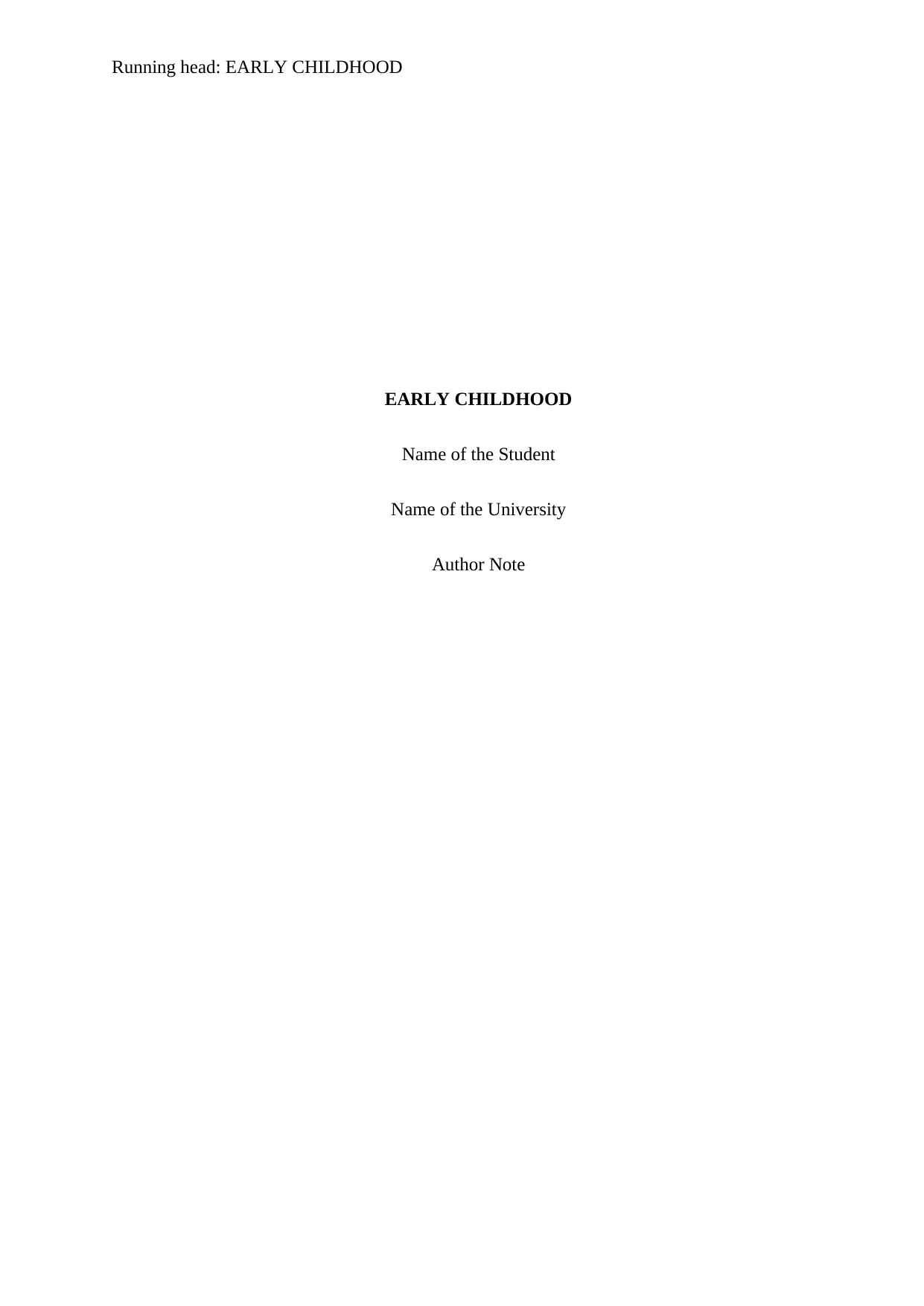
Running head: EARLY CHILDHOOD
EARLY CHILDHOOD
Name of the Student
Name of the University
Author Note
EARLY CHILDHOOD
Name of the Student
Name of the University
Author Note
Paraphrase This Document
Need a fresh take? Get an instant paraphrase of this document with our AI Paraphraser
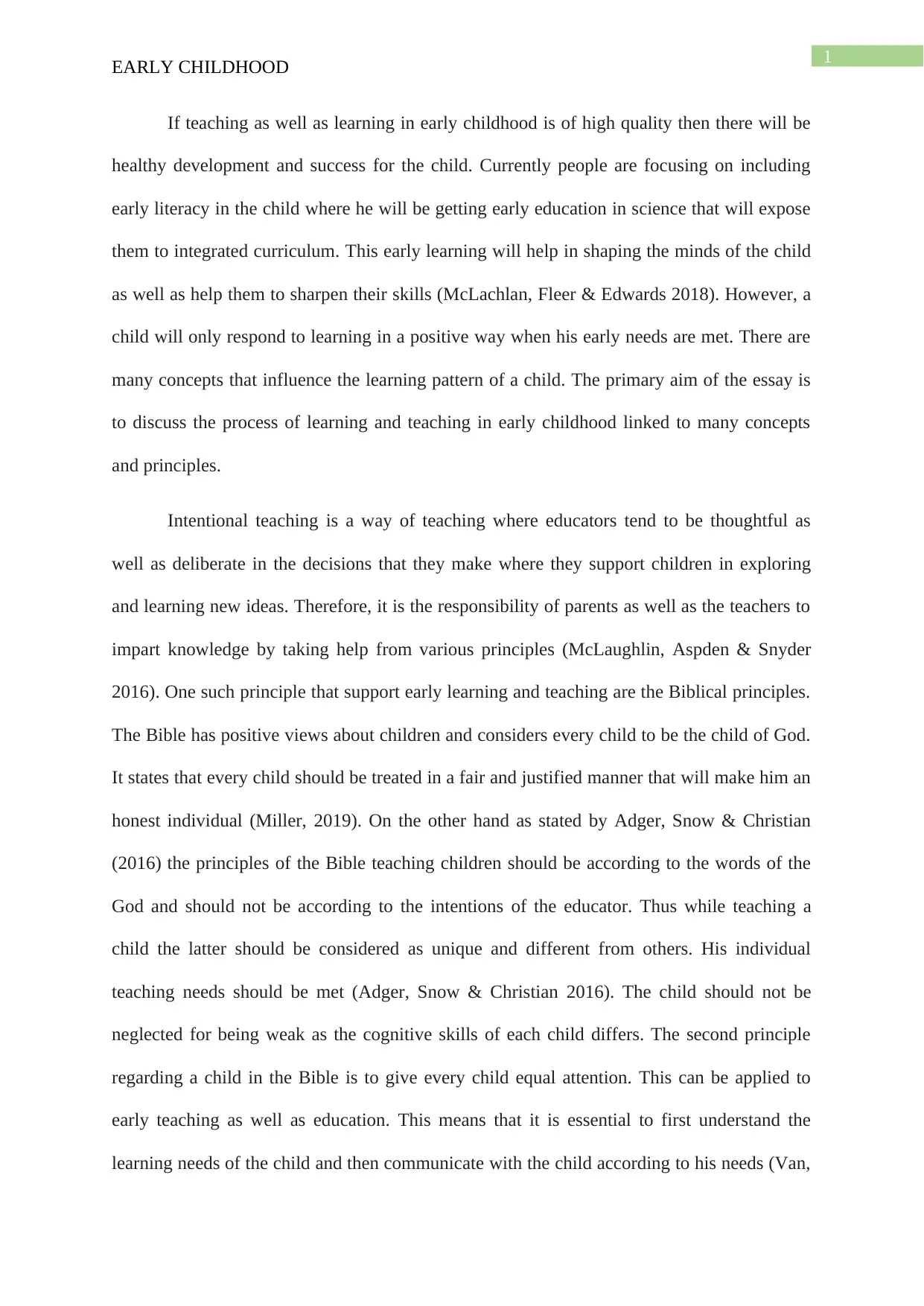
1
EARLY CHILDHOOD
If teaching as well as learning in early childhood is of high quality then there will be
healthy development and success for the child. Currently people are focusing on including
early literacy in the child where he will be getting early education in science that will expose
them to integrated curriculum. This early learning will help in shaping the minds of the child
as well as help them to sharpen their skills (McLachlan, Fleer & Edwards 2018). However, a
child will only respond to learning in a positive way when his early needs are met. There are
many concepts that influence the learning pattern of a child. The primary aim of the essay is
to discuss the process of learning and teaching in early childhood linked to many concepts
and principles.
Intentional teaching is a way of teaching where educators tend to be thoughtful as
well as deliberate in the decisions that they make where they support children in exploring
and learning new ideas. Therefore, it is the responsibility of parents as well as the teachers to
impart knowledge by taking help from various principles (McLaughlin, Aspden & Snyder
2016). One such principle that support early learning and teaching are the Biblical principles.
The Bible has positive views about children and considers every child to be the child of God.
It states that every child should be treated in a fair and justified manner that will make him an
honest individual (Miller, 2019). On the other hand as stated by Adger, Snow & Christian
(2016) the principles of the Bible teaching children should be according to the words of the
God and should not be according to the intentions of the educator. Thus while teaching a
child the latter should be considered as unique and different from others. His individual
teaching needs should be met (Adger, Snow & Christian 2016). The child should not be
neglected for being weak as the cognitive skills of each child differs. The second principle
regarding a child in the Bible is to give every child equal attention. This can be applied to
early teaching as well as education. This means that it is essential to first understand the
learning needs of the child and then communicate with the child according to his needs (Van,
EARLY CHILDHOOD
If teaching as well as learning in early childhood is of high quality then there will be
healthy development and success for the child. Currently people are focusing on including
early literacy in the child where he will be getting early education in science that will expose
them to integrated curriculum. This early learning will help in shaping the minds of the child
as well as help them to sharpen their skills (McLachlan, Fleer & Edwards 2018). However, a
child will only respond to learning in a positive way when his early needs are met. There are
many concepts that influence the learning pattern of a child. The primary aim of the essay is
to discuss the process of learning and teaching in early childhood linked to many concepts
and principles.
Intentional teaching is a way of teaching where educators tend to be thoughtful as
well as deliberate in the decisions that they make where they support children in exploring
and learning new ideas. Therefore, it is the responsibility of parents as well as the teachers to
impart knowledge by taking help from various principles (McLaughlin, Aspden & Snyder
2016). One such principle that support early learning and teaching are the Biblical principles.
The Bible has positive views about children and considers every child to be the child of God.
It states that every child should be treated in a fair and justified manner that will make him an
honest individual (Miller, 2019). On the other hand as stated by Adger, Snow & Christian
(2016) the principles of the Bible teaching children should be according to the words of the
God and should not be according to the intentions of the educator. Thus while teaching a
child the latter should be considered as unique and different from others. His individual
teaching needs should be met (Adger, Snow & Christian 2016). The child should not be
neglected for being weak as the cognitive skills of each child differs. The second principle
regarding a child in the Bible is to give every child equal attention. This can be applied to
early teaching as well as education. This means that it is essential to first understand the
learning needs of the child and then communicate with the child according to his needs (Van,

2
EARLY CHILDHOOD
2018). To give attention to the child it is necessary to maintain eye contact with him so that
they feel wanted.
Furthermore Van (2018) states that there is principle of praise for every child that has
been mentioned in the Bible. This again can be applied to early education where the child
should be praised for his god work that will encourage him to do more activities and learn
new things. If children are not praised and encouraged for their work then it lowers their
morale and discourages them (Van, 2018). Therefore, every child should be appreciated for
their pace of learning that will help them to sharpen their cognitive as well as motor skills.
Thirdly the biblical principle states that there should be encouragement for every child. This
encouragement can be in the form of rewards as well as new activities that will help the child
to further explore themselves and interact with other children that will shape their social skills
(Adger, Snow & Christian 2016). Again as mentioned by McLaughlin, Aspden & Snyder
(2016) teaching children about biblical principles will help them appreciate themselves as
well as their identity. When children will know how they came they will be able to
understand world from the perspective of God. The educators can also teach children the
value of respect that is also one of the principles in the Bible (McLaughlin, Aspden &
Snyder, 2016). One of the most essential principle regarding children that is mentioned in the
Bible is giving the child utmost care and affection (Gilson, 2019). The two aspects are crucial
for the development as well as learning in early childhood that will help the child to raise his
bar and try new things in the field of learning that will help in developing his brain.
As the principles of the Bible talks about the child and the educator the concept of
constructivism is different from the former. The constructivist focuses on the social context
as well as the larger community that does not depend on the instructions that is individually
based but focuses on the teaching among large peers and students (Chambers, Cheung &
Slavin, 2016). There are two kinds of constructivism that help the early childhood learning as
EARLY CHILDHOOD
2018). To give attention to the child it is necessary to maintain eye contact with him so that
they feel wanted.
Furthermore Van (2018) states that there is principle of praise for every child that has
been mentioned in the Bible. This again can be applied to early education where the child
should be praised for his god work that will encourage him to do more activities and learn
new things. If children are not praised and encouraged for their work then it lowers their
morale and discourages them (Van, 2018). Therefore, every child should be appreciated for
their pace of learning that will help them to sharpen their cognitive as well as motor skills.
Thirdly the biblical principle states that there should be encouragement for every child. This
encouragement can be in the form of rewards as well as new activities that will help the child
to further explore themselves and interact with other children that will shape their social skills
(Adger, Snow & Christian 2016). Again as mentioned by McLaughlin, Aspden & Snyder
(2016) teaching children about biblical principles will help them appreciate themselves as
well as their identity. When children will know how they came they will be able to
understand world from the perspective of God. The educators can also teach children the
value of respect that is also one of the principles in the Bible (McLaughlin, Aspden &
Snyder, 2016). One of the most essential principle regarding children that is mentioned in the
Bible is giving the child utmost care and affection (Gilson, 2019). The two aspects are crucial
for the development as well as learning in early childhood that will help the child to raise his
bar and try new things in the field of learning that will help in developing his brain.
As the principles of the Bible talks about the child and the educator the concept of
constructivism is different from the former. The constructivist focuses on the social context
as well as the larger community that does not depend on the instructions that is individually
based but focuses on the teaching among large peers and students (Chambers, Cheung &
Slavin, 2016). There are two kinds of constructivism that help the early childhood learning as
⊘ This is a preview!⊘
Do you want full access?
Subscribe today to unlock all pages.

Trusted by 1+ million students worldwide

3
EARLY CHILDHOOD
well as teaching they are- cognitive constructivism as well as sociocultural constructivism.
These theories dates back to John Locke who stated that knowledge comes from experience
and mention of Jean Jacques Rousseau should also be made who stated that education should
be child centered where the child plays the role of the determiner and decided what
knowledge is essential to learn (Chambers, Cheung & Slavin, 2016). On the other hand John
Dewey mentioned that all knowledge is derived from social relationships. Cognitive
constructivism is based on Jean Piaget’s theory of cognitive development. He stated that child
is an explorer who investigates the things that are around him and tries to construct his own
understanding according to the experience that the child goes through (Pardjono, 2016).
According to him there are three types of experience that is related to knowledge construction
such as- physical, mathematical and social experience. The theory was essential as it laid
down the different levels of development that enabled them to construct their learning (Waite,
2017). On the other hand social constructivism theory was propagated by Lev Vygotsky
where he emphasized on the importance of society, language as well as culture towards the
construction of knowledge (Pardjono, 2016). According to him knowledge is socially
constructed and children learn within social as well as physical context. Learning during early
childhood according through the concept of constructivism occurs when the child interact
socially with other individuals (Bozkurt, 2017). In both the forms of constructivism learning
is seen as in essential aspect in the life of the child where children responds according to their
experiences as well as understanding (Aljohani, 2017). Though the several concepts of
constructivism is almost same in their vision of educating children yet there is a difference in
the role of the teacher. Every teacher has different methods and strategies of teaching and
making the child learn. Therefore, every teacher to make the constructivist approach
successful should play the role of a guide as well as a facilitator.
EARLY CHILDHOOD
well as teaching they are- cognitive constructivism as well as sociocultural constructivism.
These theories dates back to John Locke who stated that knowledge comes from experience
and mention of Jean Jacques Rousseau should also be made who stated that education should
be child centered where the child plays the role of the determiner and decided what
knowledge is essential to learn (Chambers, Cheung & Slavin, 2016). On the other hand John
Dewey mentioned that all knowledge is derived from social relationships. Cognitive
constructivism is based on Jean Piaget’s theory of cognitive development. He stated that child
is an explorer who investigates the things that are around him and tries to construct his own
understanding according to the experience that the child goes through (Pardjono, 2016).
According to him there are three types of experience that is related to knowledge construction
such as- physical, mathematical and social experience. The theory was essential as it laid
down the different levels of development that enabled them to construct their learning (Waite,
2017). On the other hand social constructivism theory was propagated by Lev Vygotsky
where he emphasized on the importance of society, language as well as culture towards the
construction of knowledge (Pardjono, 2016). According to him knowledge is socially
constructed and children learn within social as well as physical context. Learning during early
childhood according through the concept of constructivism occurs when the child interact
socially with other individuals (Bozkurt, 2017). In both the forms of constructivism learning
is seen as in essential aspect in the life of the child where children responds according to their
experiences as well as understanding (Aljohani, 2017). Though the several concepts of
constructivism is almost same in their vision of educating children yet there is a difference in
the role of the teacher. Every teacher has different methods and strategies of teaching and
making the child learn. Therefore, every teacher to make the constructivist approach
successful should play the role of a guide as well as a facilitator.
Paraphrase This Document
Need a fresh take? Get an instant paraphrase of this document with our AI Paraphraser
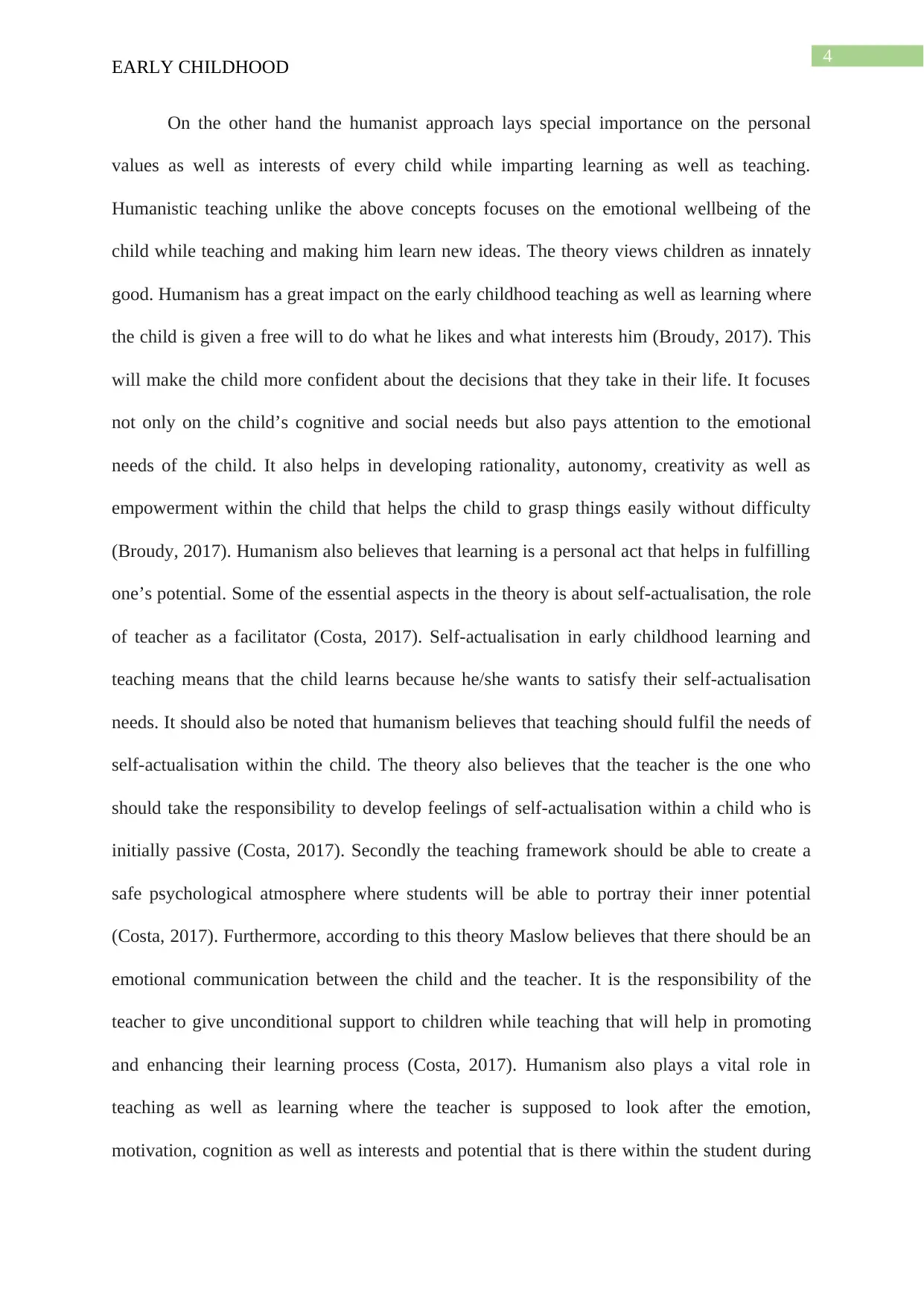
4
EARLY CHILDHOOD
On the other hand the humanist approach lays special importance on the personal
values as well as interests of every child while imparting learning as well as teaching.
Humanistic teaching unlike the above concepts focuses on the emotional wellbeing of the
child while teaching and making him learn new ideas. The theory views children as innately
good. Humanism has a great impact on the early childhood teaching as well as learning where
the child is given a free will to do what he likes and what interests him (Broudy, 2017). This
will make the child more confident about the decisions that they take in their life. It focuses
not only on the child’s cognitive and social needs but also pays attention to the emotional
needs of the child. It also helps in developing rationality, autonomy, creativity as well as
empowerment within the child that helps the child to grasp things easily without difficulty
(Broudy, 2017). Humanism also believes that learning is a personal act that helps in fulfilling
one’s potential. Some of the essential aspects in the theory is about self-actualisation, the role
of teacher as a facilitator (Costa, 2017). Self-actualisation in early childhood learning and
teaching means that the child learns because he/she wants to satisfy their self-actualisation
needs. It should also be noted that humanism believes that teaching should fulfil the needs of
self-actualisation within the child. The theory also believes that the teacher is the one who
should take the responsibility to develop feelings of self-actualisation within a child who is
initially passive (Costa, 2017). Secondly the teaching framework should be able to create a
safe psychological atmosphere where students will be able to portray their inner potential
(Costa, 2017). Furthermore, according to this theory Maslow believes that there should be an
emotional communication between the child and the teacher. It is the responsibility of the
teacher to give unconditional support to children while teaching that will help in promoting
and enhancing their learning process (Costa, 2017). Humanism also plays a vital role in
teaching as well as learning where the teacher is supposed to look after the emotion,
motivation, cognition as well as interests and potential that is there within the student during
EARLY CHILDHOOD
On the other hand the humanist approach lays special importance on the personal
values as well as interests of every child while imparting learning as well as teaching.
Humanistic teaching unlike the above concepts focuses on the emotional wellbeing of the
child while teaching and making him learn new ideas. The theory views children as innately
good. Humanism has a great impact on the early childhood teaching as well as learning where
the child is given a free will to do what he likes and what interests him (Broudy, 2017). This
will make the child more confident about the decisions that they take in their life. It focuses
not only on the child’s cognitive and social needs but also pays attention to the emotional
needs of the child. It also helps in developing rationality, autonomy, creativity as well as
empowerment within the child that helps the child to grasp things easily without difficulty
(Broudy, 2017). Humanism also believes that learning is a personal act that helps in fulfilling
one’s potential. Some of the essential aspects in the theory is about self-actualisation, the role
of teacher as a facilitator (Costa, 2017). Self-actualisation in early childhood learning and
teaching means that the child learns because he/she wants to satisfy their self-actualisation
needs. It should also be noted that humanism believes that teaching should fulfil the needs of
self-actualisation within the child. The theory also believes that the teacher is the one who
should take the responsibility to develop feelings of self-actualisation within a child who is
initially passive (Costa, 2017). Secondly the teaching framework should be able to create a
safe psychological atmosphere where students will be able to portray their inner potential
(Costa, 2017). Furthermore, according to this theory Maslow believes that there should be an
emotional communication between the child and the teacher. It is the responsibility of the
teacher to give unconditional support to children while teaching that will help in promoting
and enhancing their learning process (Costa, 2017). Humanism also plays a vital role in
teaching as well as learning where the teacher is supposed to look after the emotion,
motivation, cognition as well as interests and potential that is there within the student during

5
EARLY CHILDHOOD
the learning process. The theory encourages the teachers as well as other educators who are
involved in early childhood education to think about the students and encourage them to feel
the enthusiasm as well as interests towards learning (Duff, Rubenstein & Prilleltensky 2016).
Therefore from the above points it is clear that humanism has a psychological impact on the
teaching as well as process of learning in the early childhood.
On the other hand impact of post-modernism on early childhood teaching and learning
is very different from the concepts that has been discussed above. Post-modernism affects
early childhood education in several ways (Taggart, 2016). Unlike biblical principles,
humanism and constructivism, post-modernism pays attention to the development of the early
childhood education that focuses on critical thinking of the child, his development of self-
identity and creation, and production of knowledge (Nicholson & Maniates 2016). Post-
modernism allows the teachers to give the students an opportunity to discover as well as
explore new things. The theory allows the teachers to make their teaching style more creative
that will attract the attention of the students and will also urge them to be creative (Nicholson
& Maniates 2016). In this scenario the child always tends to listen to the teachers where they
are able to tolerate criticism and think in a critical way. Post modernism also has another
impact on the learning and teaching process in the early childhood that is the children are able
to learn as well as respect other people (Roberts, 2017). The child also develop skills to work
independently where he starts understanding verbal methods. It should be noted that post-
modernism as well as creativity are interlinked with each other therefore it has a creative
impact on early childhood learning and teaching. Post modernism not only has an impact on
children but also on the teachers as well (Roberts, 2017). The role of the teacher according to
this theory is create new boundaries as well as possibilities for the child to learn. It is the
responsibility of the teacher to provide students with different analytical tools that will help
them to view practices from different perspectives that provides them with alternative ways
EARLY CHILDHOOD
the learning process. The theory encourages the teachers as well as other educators who are
involved in early childhood education to think about the students and encourage them to feel
the enthusiasm as well as interests towards learning (Duff, Rubenstein & Prilleltensky 2016).
Therefore from the above points it is clear that humanism has a psychological impact on the
teaching as well as process of learning in the early childhood.
On the other hand impact of post-modernism on early childhood teaching and learning
is very different from the concepts that has been discussed above. Post-modernism affects
early childhood education in several ways (Taggart, 2016). Unlike biblical principles,
humanism and constructivism, post-modernism pays attention to the development of the early
childhood education that focuses on critical thinking of the child, his development of self-
identity and creation, and production of knowledge (Nicholson & Maniates 2016). Post-
modernism allows the teachers to give the students an opportunity to discover as well as
explore new things. The theory allows the teachers to make their teaching style more creative
that will attract the attention of the students and will also urge them to be creative (Nicholson
& Maniates 2016). In this scenario the child always tends to listen to the teachers where they
are able to tolerate criticism and think in a critical way. Post modernism also has another
impact on the learning and teaching process in the early childhood that is the children are able
to learn as well as respect other people (Roberts, 2017). The child also develop skills to work
independently where he starts understanding verbal methods. It should be noted that post-
modernism as well as creativity are interlinked with each other therefore it has a creative
impact on early childhood learning and teaching. Post modernism not only has an impact on
children but also on the teachers as well (Roberts, 2017). The role of the teacher according to
this theory is create new boundaries as well as possibilities for the child to learn. It is the
responsibility of the teacher to provide students with different analytical tools that will help
them to view practices from different perspectives that provides them with alternative ways
⊘ This is a preview!⊘
Do you want full access?
Subscribe today to unlock all pages.

Trusted by 1+ million students worldwide
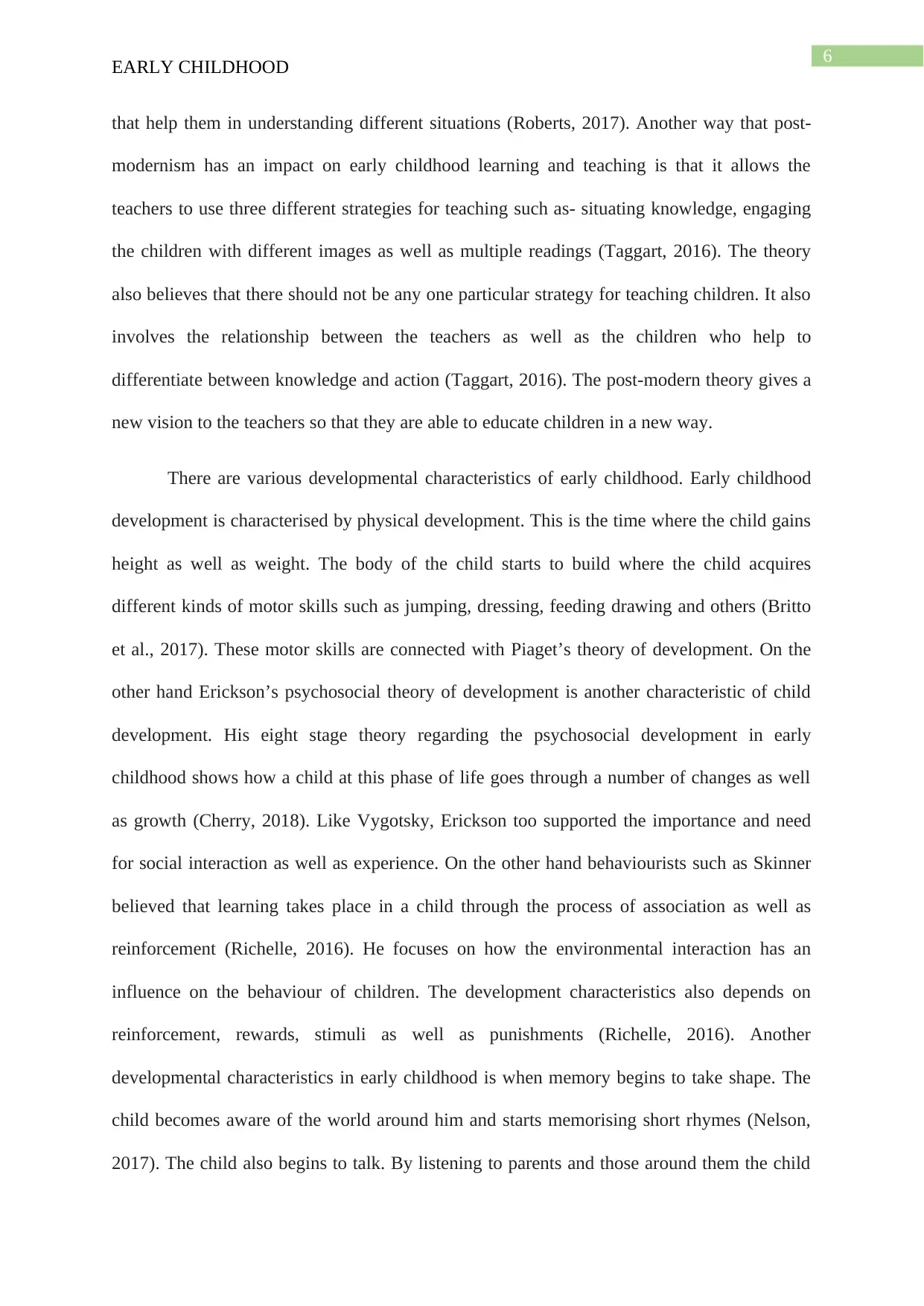
6
EARLY CHILDHOOD
that help them in understanding different situations (Roberts, 2017). Another way that post-
modernism has an impact on early childhood learning and teaching is that it allows the
teachers to use three different strategies for teaching such as- situating knowledge, engaging
the children with different images as well as multiple readings (Taggart, 2016). The theory
also believes that there should not be any one particular strategy for teaching children. It also
involves the relationship between the teachers as well as the children who help to
differentiate between knowledge and action (Taggart, 2016). The post-modern theory gives a
new vision to the teachers so that they are able to educate children in a new way.
There are various developmental characteristics of early childhood. Early childhood
development is characterised by physical development. This is the time where the child gains
height as well as weight. The body of the child starts to build where the child acquires
different kinds of motor skills such as jumping, dressing, feeding drawing and others (Britto
et al., 2017). These motor skills are connected with Piaget’s theory of development. On the
other hand Erickson’s psychosocial theory of development is another characteristic of child
development. His eight stage theory regarding the psychosocial development in early
childhood shows how a child at this phase of life goes through a number of changes as well
as growth (Cherry, 2018). Like Vygotsky, Erickson too supported the importance and need
for social interaction as well as experience. On the other hand behaviourists such as Skinner
believed that learning takes place in a child through the process of association as well as
reinforcement (Richelle, 2016). He focuses on how the environmental interaction has an
influence on the behaviour of children. The development characteristics also depends on
reinforcement, rewards, stimuli as well as punishments (Richelle, 2016). Another
developmental characteristics in early childhood is when memory begins to take shape. The
child becomes aware of the world around him and starts memorising short rhymes (Nelson,
2017). The child also begins to talk. By listening to parents and those around them the child
EARLY CHILDHOOD
that help them in understanding different situations (Roberts, 2017). Another way that post-
modernism has an impact on early childhood learning and teaching is that it allows the
teachers to use three different strategies for teaching such as- situating knowledge, engaging
the children with different images as well as multiple readings (Taggart, 2016). The theory
also believes that there should not be any one particular strategy for teaching children. It also
involves the relationship between the teachers as well as the children who help to
differentiate between knowledge and action (Taggart, 2016). The post-modern theory gives a
new vision to the teachers so that they are able to educate children in a new way.
There are various developmental characteristics of early childhood. Early childhood
development is characterised by physical development. This is the time where the child gains
height as well as weight. The body of the child starts to build where the child acquires
different kinds of motor skills such as jumping, dressing, feeding drawing and others (Britto
et al., 2017). These motor skills are connected with Piaget’s theory of development. On the
other hand Erickson’s psychosocial theory of development is another characteristic of child
development. His eight stage theory regarding the psychosocial development in early
childhood shows how a child at this phase of life goes through a number of changes as well
as growth (Cherry, 2018). Like Vygotsky, Erickson too supported the importance and need
for social interaction as well as experience. On the other hand behaviourists such as Skinner
believed that learning takes place in a child through the process of association as well as
reinforcement (Richelle, 2016). He focuses on how the environmental interaction has an
influence on the behaviour of children. The development characteristics also depends on
reinforcement, rewards, stimuli as well as punishments (Richelle, 2016). Another
developmental characteristics in early childhood is when memory begins to take shape. The
child becomes aware of the world around him and starts memorising short rhymes (Nelson,
2017). The child also begins to talk. By listening to parents and those around them the child
Paraphrase This Document
Need a fresh take? Get an instant paraphrase of this document with our AI Paraphraser
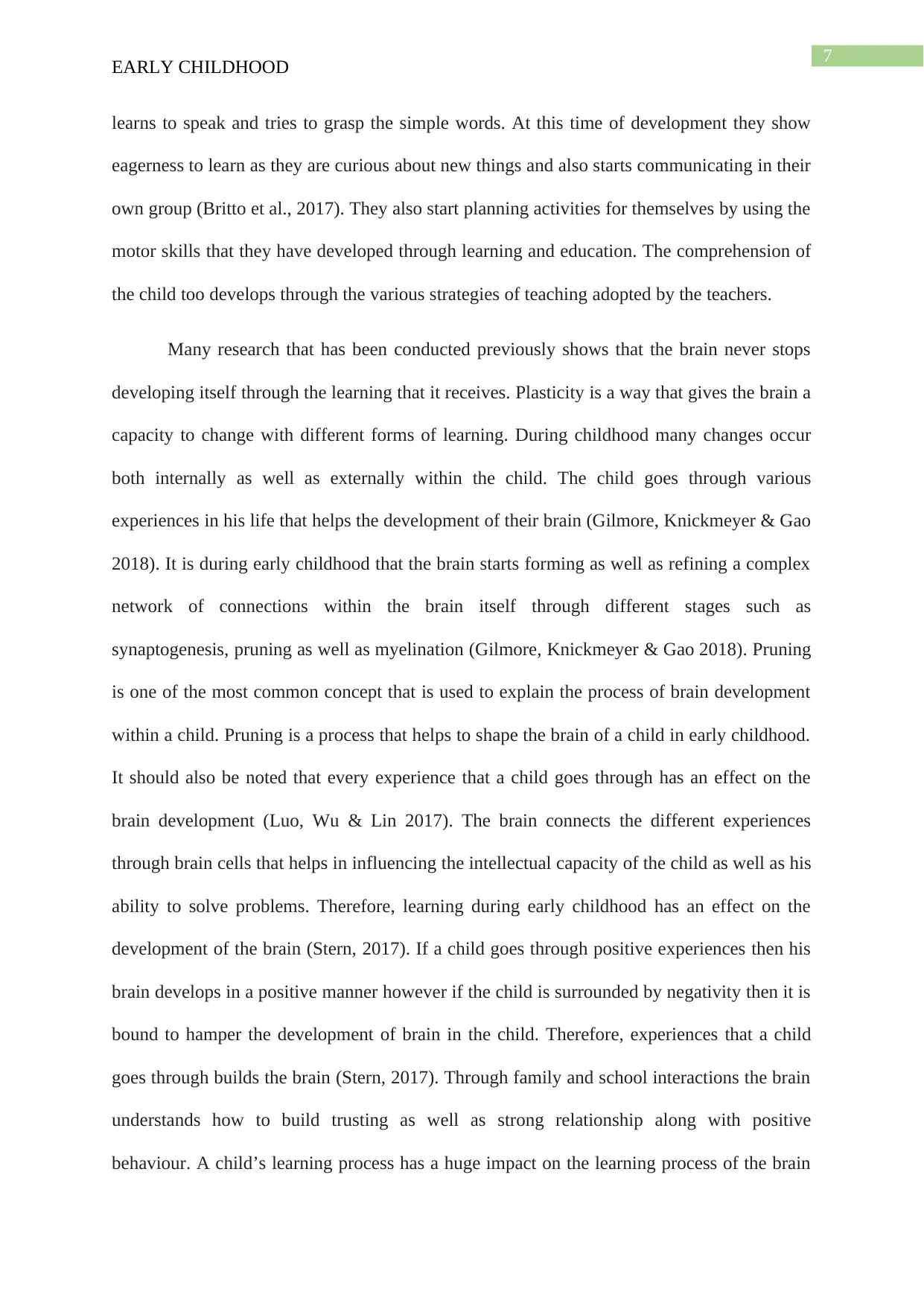
7
EARLY CHILDHOOD
learns to speak and tries to grasp the simple words. At this time of development they show
eagerness to learn as they are curious about new things and also starts communicating in their
own group (Britto et al., 2017). They also start planning activities for themselves by using the
motor skills that they have developed through learning and education. The comprehension of
the child too develops through the various strategies of teaching adopted by the teachers.
Many research that has been conducted previously shows that the brain never stops
developing itself through the learning that it receives. Plasticity is a way that gives the brain a
capacity to change with different forms of learning. During childhood many changes occur
both internally as well as externally within the child. The child goes through various
experiences in his life that helps the development of their brain (Gilmore, Knickmeyer & Gao
2018). It is during early childhood that the brain starts forming as well as refining a complex
network of connections within the brain itself through different stages such as
synaptogenesis, pruning as well as myelination (Gilmore, Knickmeyer & Gao 2018). Pruning
is one of the most common concept that is used to explain the process of brain development
within a child. Pruning is a process that helps to shape the brain of a child in early childhood.
It should also be noted that every experience that a child goes through has an effect on the
brain development (Luo, Wu & Lin 2017). The brain connects the different experiences
through brain cells that helps in influencing the intellectual capacity of the child as well as his
ability to solve problems. Therefore, learning during early childhood has an effect on the
development of the brain (Stern, 2017). If a child goes through positive experiences then his
brain develops in a positive manner however if the child is surrounded by negativity then it is
bound to hamper the development of brain in the child. Therefore, experiences that a child
goes through builds the brain (Stern, 2017). Through family and school interactions the brain
understands how to build trusting as well as strong relationship along with positive
behaviour. A child’s learning process has a huge impact on the learning process of the brain
EARLY CHILDHOOD
learns to speak and tries to grasp the simple words. At this time of development they show
eagerness to learn as they are curious about new things and also starts communicating in their
own group (Britto et al., 2017). They also start planning activities for themselves by using the
motor skills that they have developed through learning and education. The comprehension of
the child too develops through the various strategies of teaching adopted by the teachers.
Many research that has been conducted previously shows that the brain never stops
developing itself through the learning that it receives. Plasticity is a way that gives the brain a
capacity to change with different forms of learning. During childhood many changes occur
both internally as well as externally within the child. The child goes through various
experiences in his life that helps the development of their brain (Gilmore, Knickmeyer & Gao
2018). It is during early childhood that the brain starts forming as well as refining a complex
network of connections within the brain itself through different stages such as
synaptogenesis, pruning as well as myelination (Gilmore, Knickmeyer & Gao 2018). Pruning
is one of the most common concept that is used to explain the process of brain development
within a child. Pruning is a process that helps to shape the brain of a child in early childhood.
It should also be noted that every experience that a child goes through has an effect on the
brain development (Luo, Wu & Lin 2017). The brain connects the different experiences
through brain cells that helps in influencing the intellectual capacity of the child as well as his
ability to solve problems. Therefore, learning during early childhood has an effect on the
development of the brain (Stern, 2017). If a child goes through positive experiences then his
brain develops in a positive manner however if the child is surrounded by negativity then it is
bound to hamper the development of brain in the child. Therefore, experiences that a child
goes through builds the brain (Stern, 2017). Through family and school interactions the brain
understands how to build trusting as well as strong relationship along with positive
behaviour. A child’s learning process has a huge impact on the learning process of the brain
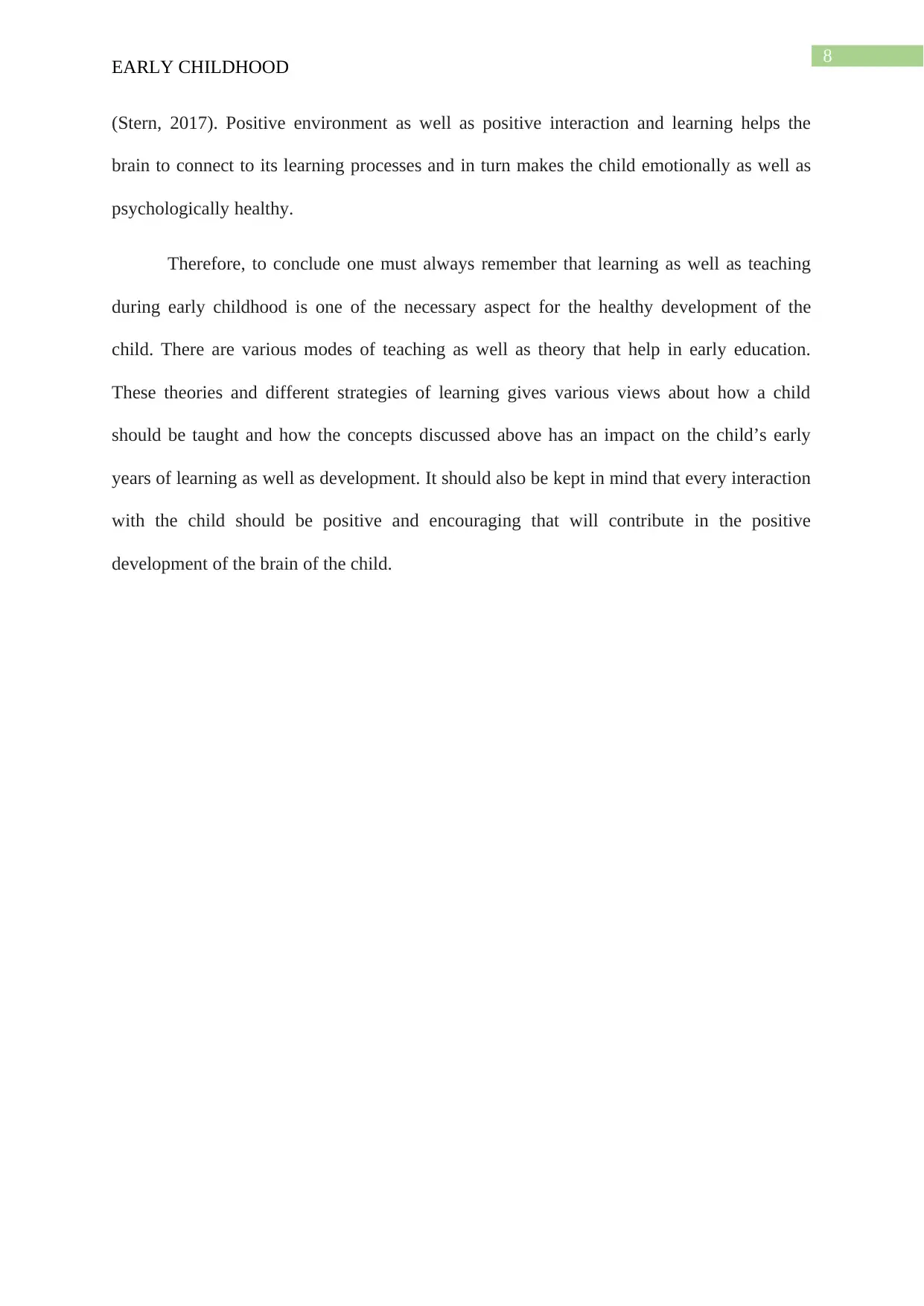
8
EARLY CHILDHOOD
(Stern, 2017). Positive environment as well as positive interaction and learning helps the
brain to connect to its learning processes and in turn makes the child emotionally as well as
psychologically healthy.
Therefore, to conclude one must always remember that learning as well as teaching
during early childhood is one of the necessary aspect for the healthy development of the
child. There are various modes of teaching as well as theory that help in early education.
These theories and different strategies of learning gives various views about how a child
should be taught and how the concepts discussed above has an impact on the child’s early
years of learning as well as development. It should also be kept in mind that every interaction
with the child should be positive and encouraging that will contribute in the positive
development of the brain of the child.
EARLY CHILDHOOD
(Stern, 2017). Positive environment as well as positive interaction and learning helps the
brain to connect to its learning processes and in turn makes the child emotionally as well as
psychologically healthy.
Therefore, to conclude one must always remember that learning as well as teaching
during early childhood is one of the necessary aspect for the healthy development of the
child. There are various modes of teaching as well as theory that help in early education.
These theories and different strategies of learning gives various views about how a child
should be taught and how the concepts discussed above has an impact on the child’s early
years of learning as well as development. It should also be kept in mind that every interaction
with the child should be positive and encouraging that will contribute in the positive
development of the brain of the child.
⊘ This is a preview!⊘
Do you want full access?
Subscribe today to unlock all pages.

Trusted by 1+ million students worldwide
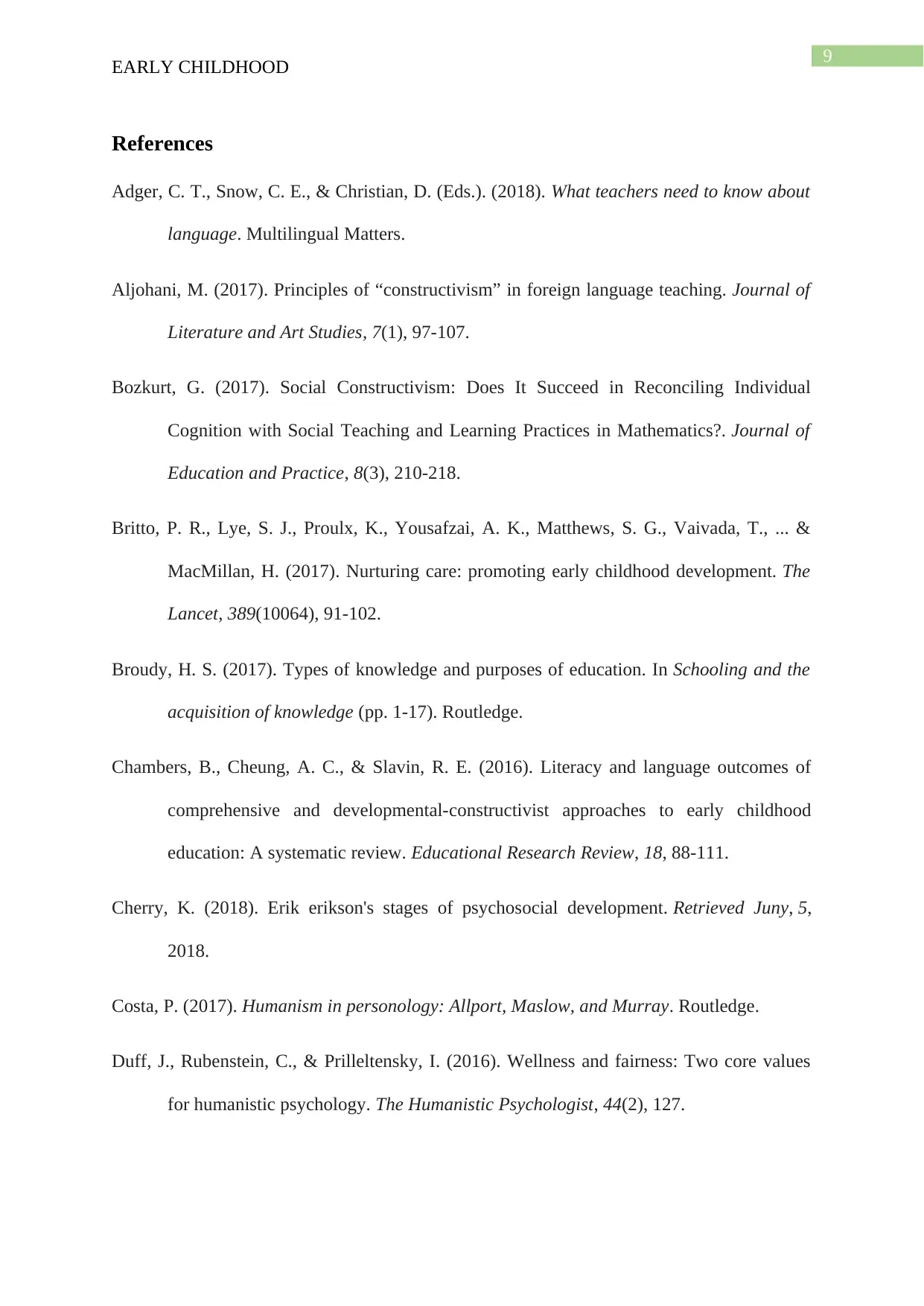
9
EARLY CHILDHOOD
References
Adger, C. T., Snow, C. E., & Christian, D. (Eds.). (2018). What teachers need to know about
language. Multilingual Matters.
Aljohani, M. (2017). Principles of “constructivism” in foreign language teaching. Journal of
Literature and Art Studies, 7(1), 97-107.
Bozkurt, G. (2017). Social Constructivism: Does It Succeed in Reconciling Individual
Cognition with Social Teaching and Learning Practices in Mathematics?. Journal of
Education and Practice, 8(3), 210-218.
Britto, P. R., Lye, S. J., Proulx, K., Yousafzai, A. K., Matthews, S. G., Vaivada, T., ... &
MacMillan, H. (2017). Nurturing care: promoting early childhood development. The
Lancet, 389(10064), 91-102.
Broudy, H. S. (2017). Types of knowledge and purposes of education. In Schooling and the
acquisition of knowledge (pp. 1-17). Routledge.
Chambers, B., Cheung, A. C., & Slavin, R. E. (2016). Literacy and language outcomes of
comprehensive and developmental-constructivist approaches to early childhood
education: A systematic review. Educational Research Review, 18, 88-111.
Cherry, K. (2018). Erik erikson's stages of psychosocial development. Retrieved Juny, 5,
2018.
Costa, P. (2017). Humanism in personology: Allport, Maslow, and Murray. Routledge.
Duff, J., Rubenstein, C., & Prilleltensky, I. (2016). Wellness and fairness: Two core values
for humanistic psychology. The Humanistic Psychologist, 44(2), 127.
EARLY CHILDHOOD
References
Adger, C. T., Snow, C. E., & Christian, D. (Eds.). (2018). What teachers need to know about
language. Multilingual Matters.
Aljohani, M. (2017). Principles of “constructivism” in foreign language teaching. Journal of
Literature and Art Studies, 7(1), 97-107.
Bozkurt, G. (2017). Social Constructivism: Does It Succeed in Reconciling Individual
Cognition with Social Teaching and Learning Practices in Mathematics?. Journal of
Education and Practice, 8(3), 210-218.
Britto, P. R., Lye, S. J., Proulx, K., Yousafzai, A. K., Matthews, S. G., Vaivada, T., ... &
MacMillan, H. (2017). Nurturing care: promoting early childhood development. The
Lancet, 389(10064), 91-102.
Broudy, H. S. (2017). Types of knowledge and purposes of education. In Schooling and the
acquisition of knowledge (pp. 1-17). Routledge.
Chambers, B., Cheung, A. C., & Slavin, R. E. (2016). Literacy and language outcomes of
comprehensive and developmental-constructivist approaches to early childhood
education: A systematic review. Educational Research Review, 18, 88-111.
Cherry, K. (2018). Erik erikson's stages of psychosocial development. Retrieved Juny, 5,
2018.
Costa, P. (2017). Humanism in personology: Allport, Maslow, and Murray. Routledge.
Duff, J., Rubenstein, C., & Prilleltensky, I. (2016). Wellness and fairness: Two core values
for humanistic psychology. The Humanistic Psychologist, 44(2), 127.
Paraphrase This Document
Need a fresh take? Get an instant paraphrase of this document with our AI Paraphraser
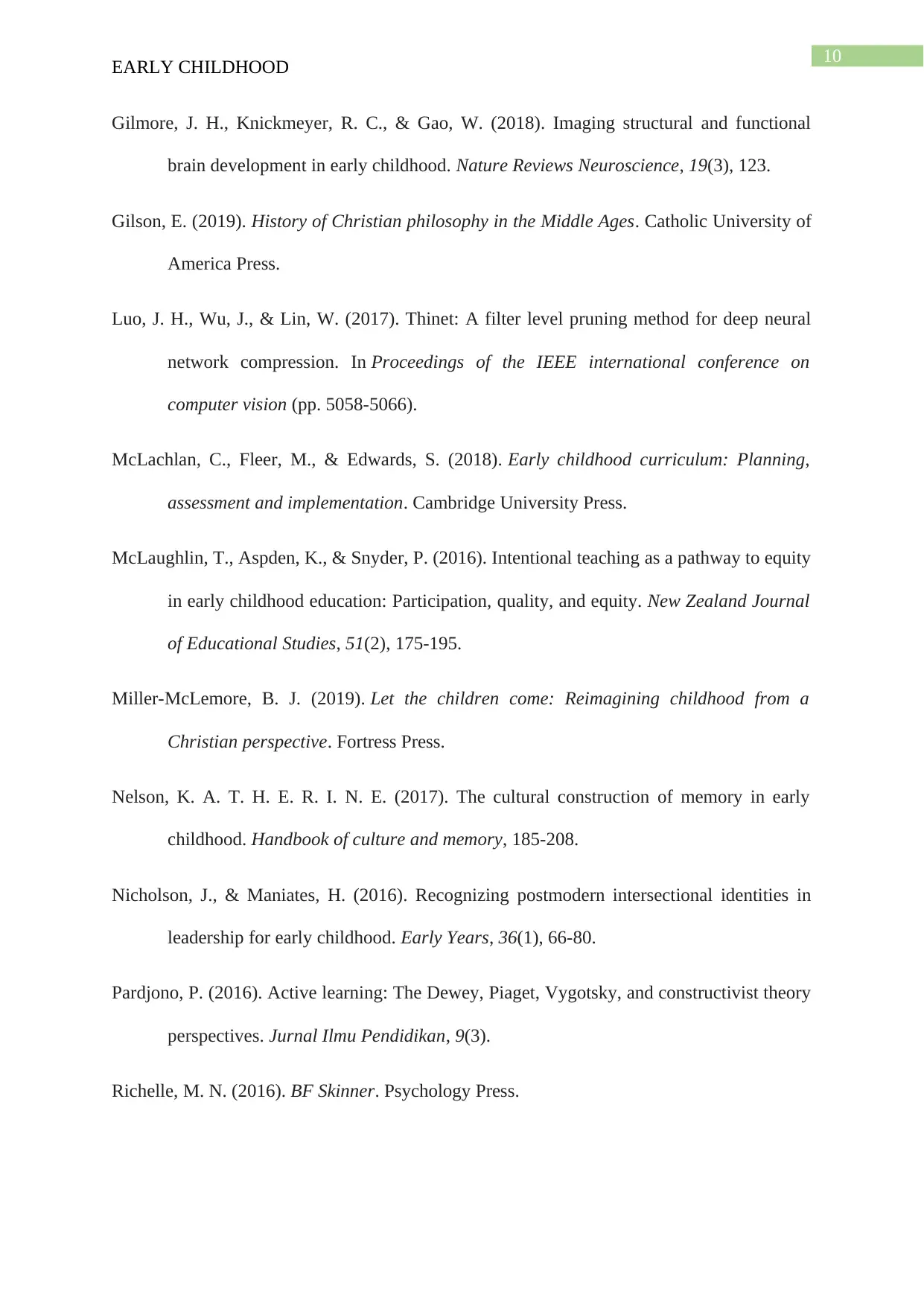
10
EARLY CHILDHOOD
Gilmore, J. H., Knickmeyer, R. C., & Gao, W. (2018). Imaging structural and functional
brain development in early childhood. Nature Reviews Neuroscience, 19(3), 123.
Gilson, E. (2019). History of Christian philosophy in the Middle Ages. Catholic University of
America Press.
Luo, J. H., Wu, J., & Lin, W. (2017). Thinet: A filter level pruning method for deep neural
network compression. In Proceedings of the IEEE international conference on
computer vision (pp. 5058-5066).
McLachlan, C., Fleer, M., & Edwards, S. (2018). Early childhood curriculum: Planning,
assessment and implementation. Cambridge University Press.
McLaughlin, T., Aspden, K., & Snyder, P. (2016). Intentional teaching as a pathway to equity
in early childhood education: Participation, quality, and equity. New Zealand Journal
of Educational Studies, 51(2), 175-195.
Miller-McLemore, B. J. (2019). Let the children come: Reimagining childhood from a
Christian perspective. Fortress Press.
Nelson, K. A. T. H. E. R. I. N. E. (2017). The cultural construction of memory in early
childhood. Handbook of culture and memory, 185-208.
Nicholson, J., & Maniates, H. (2016). Recognizing postmodern intersectional identities in
leadership for early childhood. Early Years, 36(1), 66-80.
Pardjono, P. (2016). Active learning: The Dewey, Piaget, Vygotsky, and constructivist theory
perspectives. Jurnal Ilmu Pendidikan, 9(3).
Richelle, M. N. (2016). BF Skinner. Psychology Press.
EARLY CHILDHOOD
Gilmore, J. H., Knickmeyer, R. C., & Gao, W. (2018). Imaging structural and functional
brain development in early childhood. Nature Reviews Neuroscience, 19(3), 123.
Gilson, E. (2019). History of Christian philosophy in the Middle Ages. Catholic University of
America Press.
Luo, J. H., Wu, J., & Lin, W. (2017). Thinet: A filter level pruning method for deep neural
network compression. In Proceedings of the IEEE international conference on
computer vision (pp. 5058-5066).
McLachlan, C., Fleer, M., & Edwards, S. (2018). Early childhood curriculum: Planning,
assessment and implementation. Cambridge University Press.
McLaughlin, T., Aspden, K., & Snyder, P. (2016). Intentional teaching as a pathway to equity
in early childhood education: Participation, quality, and equity. New Zealand Journal
of Educational Studies, 51(2), 175-195.
Miller-McLemore, B. J. (2019). Let the children come: Reimagining childhood from a
Christian perspective. Fortress Press.
Nelson, K. A. T. H. E. R. I. N. E. (2017). The cultural construction of memory in early
childhood. Handbook of culture and memory, 185-208.
Nicholson, J., & Maniates, H. (2016). Recognizing postmodern intersectional identities in
leadership for early childhood. Early Years, 36(1), 66-80.
Pardjono, P. (2016). Active learning: The Dewey, Piaget, Vygotsky, and constructivist theory
perspectives. Jurnal Ilmu Pendidikan, 9(3).
Richelle, M. N. (2016). BF Skinner. Psychology Press.
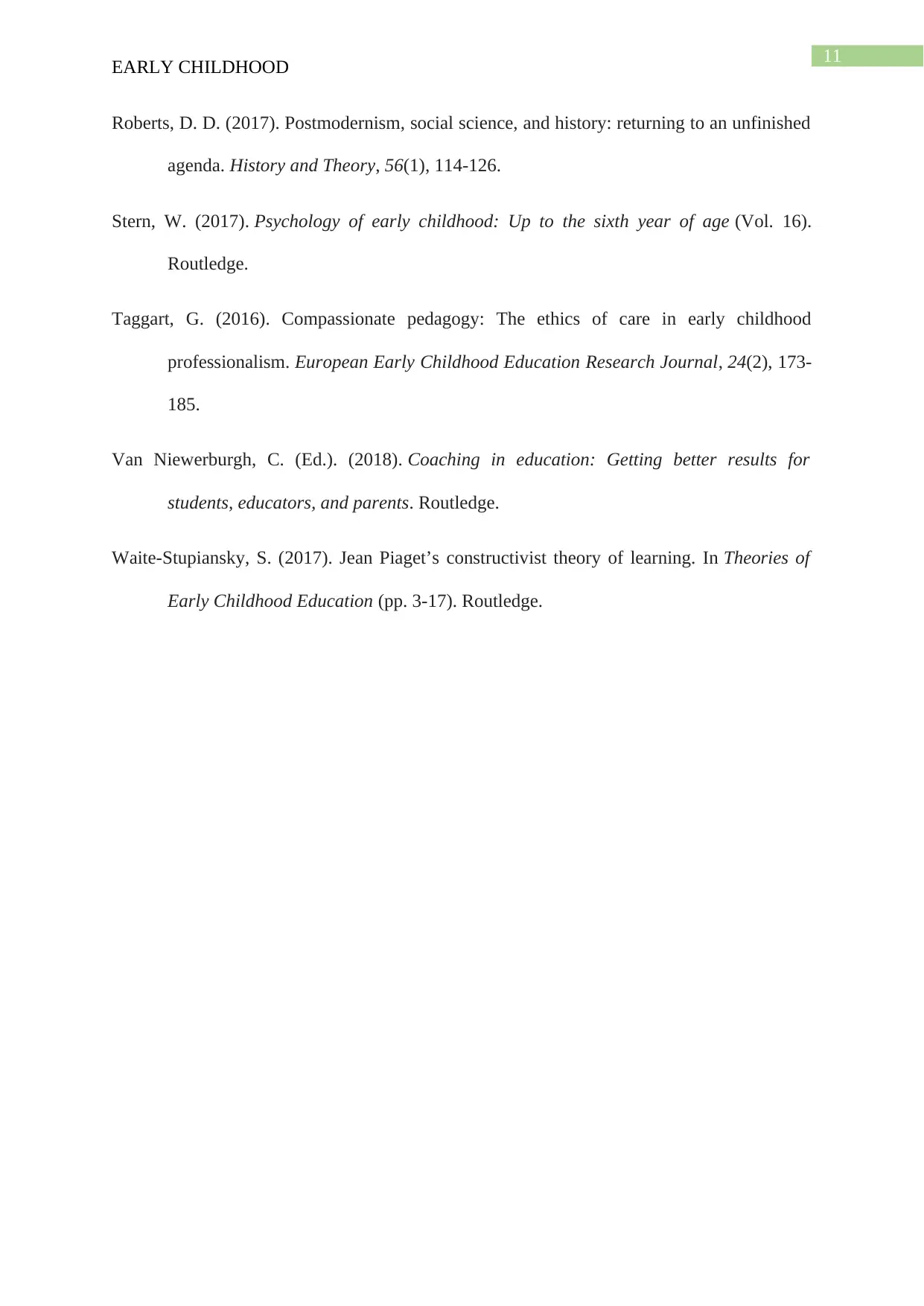
11
EARLY CHILDHOOD
Roberts, D. D. (2017). Postmodernism, social science, and history: returning to an unfinished
agenda. History and Theory, 56(1), 114-126.
Stern, W. (2017). Psychology of early childhood: Up to the sixth year of age (Vol. 16).
Routledge.
Taggart, G. (2016). Compassionate pedagogy: The ethics of care in early childhood
professionalism. European Early Childhood Education Research Journal, 24(2), 173-
185.
Van Niewerburgh, C. (Ed.). (2018). Coaching in education: Getting better results for
students, educators, and parents. Routledge.
Waite-Stupiansky, S. (2017). Jean Piaget’s constructivist theory of learning. In Theories of
Early Childhood Education (pp. 3-17). Routledge.
EARLY CHILDHOOD
Roberts, D. D. (2017). Postmodernism, social science, and history: returning to an unfinished
agenda. History and Theory, 56(1), 114-126.
Stern, W. (2017). Psychology of early childhood: Up to the sixth year of age (Vol. 16).
Routledge.
Taggart, G. (2016). Compassionate pedagogy: The ethics of care in early childhood
professionalism. European Early Childhood Education Research Journal, 24(2), 173-
185.
Van Niewerburgh, C. (Ed.). (2018). Coaching in education: Getting better results for
students, educators, and parents. Routledge.
Waite-Stupiansky, S. (2017). Jean Piaget’s constructivist theory of learning. In Theories of
Early Childhood Education (pp. 3-17). Routledge.
⊘ This is a preview!⊘
Do you want full access?
Subscribe today to unlock all pages.

Trusted by 1+ million students worldwide
1 out of 12
Related Documents
Your All-in-One AI-Powered Toolkit for Academic Success.
+13062052269
info@desklib.com
Available 24*7 on WhatsApp / Email
![[object Object]](/_next/static/media/star-bottom.7253800d.svg)
Unlock your academic potential
Copyright © 2020–2026 A2Z Services. All Rights Reserved. Developed and managed by ZUCOL.




